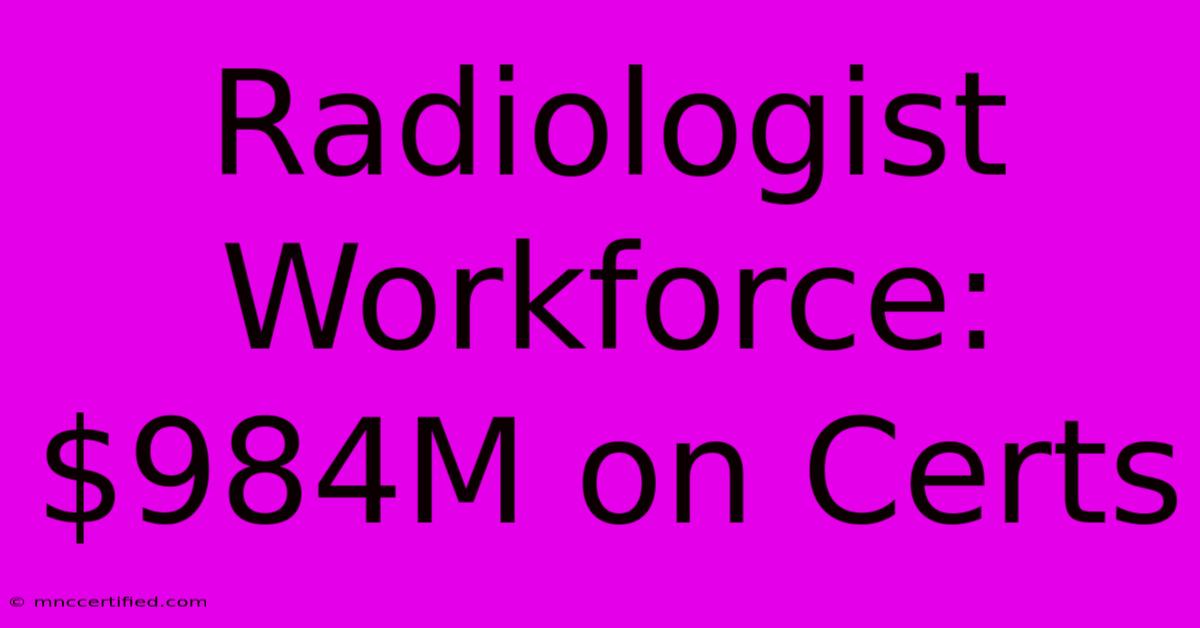Radiologist Workforce: $984M On Certs

Table of Contents
Radiologist Workforce: The $984 Million Question of Certification
The radiology field faces a critical challenge: maintaining a robust and qualified workforce. A recent report highlighted a staggering $984 million investment in certifications, revealing the significant financial commitment required to ensure radiologists possess the necessary skills and knowledge. This substantial investment underscores the importance of ongoing professional development and the complex interplay between cost, training, and the future of radiology. This article delves into the factors driving this expense, the implications for the healthcare system, and potential solutions to ensure the long-term sustainability of the radiologist workforce.
The High Cost of Maintaining Expertise: Why $984 Million?
The $984 million figure represents more than just certification fees; it encompasses a broader investment in maintaining radiologist expertise. This includes:
-
Continuing Medical Education (CME): Radiology is a rapidly evolving field. New technologies, treatment methods, and research findings necessitate continuous learning. CME courses, conferences, and online modules contribute significantly to the overall cost. Keeping abreast of the latest advancements is non-negotiable for maintaining licensure and providing high-quality patient care.
-
Certification Exams and Renewal Fees: Maintaining board certification demonstrates competency and commitment to professional standards. These exams, along with associated fees and study materials, represent a substantial portion of the $984 million. The rigorous nature of these exams ensures radiologists meet the highest standards of practice.
-
Technological Training: The radiology landscape is dominated by advanced imaging technologies like MRI, CT, PET, and ultrasound. Radiologists require extensive training to operate and interpret images from these sophisticated machines. This training is expensive and ongoing, demanding significant investment. Staying current with technology is vital for accurate diagnosis and treatment planning.
-
Subspecialty Certification: Many radiologists choose to specialize further in areas like neuroradiology, cardiovascular radiology, or musculoskeletal radiology. Pursuing subspecialty certifications requires additional training, exams, and fees, adding to the overall cost. Subspecialty training enhances expertise and improves patient outcomes in specific areas.
The Implications for the Healthcare System
The substantial investment in radiologist certification has significant implications for the healthcare system:
-
Patient Care: A well-trained and certified radiologist workforce is crucial for accurate diagnoses and effective treatment plans. This directly impacts patient outcomes and overall healthcare quality. Investing in certification ensures patients receive the best possible care.
-
Healthcare Costs: While the investment in certification is high, the potential cost savings from improved diagnoses and reduced medical errors far outweigh the initial expenditure. Preventing misdiagnosis and subsequent complications leads to long-term cost savings.
-
Healthcare Access: Ensuring an adequate supply of qualified radiologists is essential for equitable access to healthcare services, particularly in underserved areas. Addressing workforce shortages is vital for providing timely and equitable access to radiology services.
Addressing the Challenges and Ensuring a Sustainable Future
The high cost of maintaining a qualified radiologist workforce demands proactive solutions:
-
Government Funding and Incentives: Increased government funding for CME programs, certification exams, and technological training could alleviate the financial burden on radiologists and institutions. Targeted financial support is critical for sustaining the profession.
-
Innovative Training Models: Exploring innovative training methods, such as online courses and blended learning approaches, could reduce costs while maintaining high-quality education. Embracing technological advancements in training can improve efficiency and lower costs.
-
Streamlined Certification Processes: Simplifying certification processes and reducing unnecessary administrative burdens could also contribute to cost savings. Optimizing administrative processes can reduce overall expenditure.
-
Addressing Burnout and Retention: Addressing the issue of burnout among radiologists is crucial for retaining experienced professionals. Initiatives promoting work-life balance and addressing workplace stressors are vital for workforce sustainability. A supportive work environment plays a vital role in retaining talented professionals.
The $984 million investment in radiologist certification highlights the crucial role of these professionals in the healthcare system. Addressing the financial challenges and ensuring a sustainable workforce requires a collaborative effort between government agencies, healthcare institutions, and professional organizations. By implementing innovative solutions and addressing the underlying challenges, we can ensure a future where patients continue to benefit from the expertise of a highly trained and qualified radiology workforce.

Thank you for visiting our website wich cover about Radiologist Workforce: $984M On Certs. We hope the information provided has been useful to you. Feel free to contact us if you have any questions or need further assistance. See you next time and dont miss to bookmark.
Featured Posts
-
Celtics Ccv Howler Meeting Details
Nov 28, 2024
-
Giants Release Jones Vikings Sign Qb
Nov 28, 2024
-
Champions League Trading Cards
Nov 28, 2024
-
Champions League Final Liverpool Vs Real Madrid Result
Nov 28, 2024
-
Crime At Groucho Club Club Now Closed
Nov 28, 2024